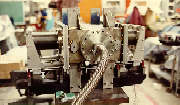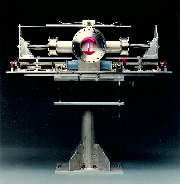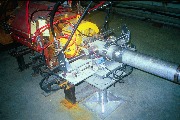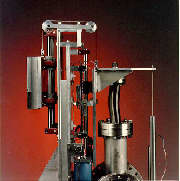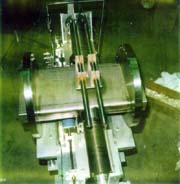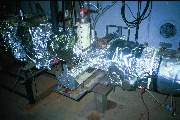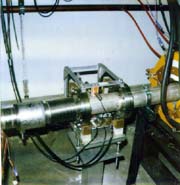Photos of the Beam Scrapers and Collimators Larry Bartoszek worked on at FermilabScrapers and collimators are devices in particle accelerators which share a common architecture, but are used for two different purposes. They both typically have blocks of heavy metal such as tungsten or stainless steel which are moved in and out of the beam pipe to collide with particles circulating in the accelerator. Scrapers tend to be beam diagnostic devices. Their blades are relatively thin in the direction of the beam and they are used in conjunction with beam loss monitors to determine where the beam is inside the beam pipe. Scrapers (and collimators) have position read-back on the location of the blade in the beam. If a scraper blade is moved across the beam aperture and at a certain point a signal comes from beam loss monitors downstream of the scraper, then the operator knows that the beam's edge must be at the location of the blade in the beam pipe. Collimators are typically used to select a portion of the beam coming down a beam transfer line and reject the rest. Their blades tend to be longer in the direction of the beam so that multiple scattering between particles in the beam and the collimator block will ensure that unwanted particles are deflected out of the beam pipe. Collimation narrows the range of particle angles or momentum in the beam pipe to those that "fit" into the accelerator. The studio images were taken by the talented people of the Fermilab Media Services of projects designed by Larry Bartoszek. The rest were taken by Larry. You are welcome to download any of the images. If they are used for other than private viewing, credit to Bartoszek Engineering and Fermilab would be appreciated. (Presentation of photos from Fermilab does not imply endorsement of any product or service.)
The AP2 collimators were my first collimator design at Fermilab. They hang from the ceiling in the AP2 beam-line and select antiprotons generated in the target hall for injection into the Debuncher Ring. The stainless steel vaccum box in the picture hides the actual blocks of stainless steel that move inside the vessel. The collimator blocks are mounted on arms attached to the inside of vacuum flanges, which are mounted on a linear bearing assembly. The vacuum is sealed by a metal bellows which allows the blocks to be moved back and forth inside the vessel by the screw drive unit and the linear bearings. The flange with the metal flex hose coming out of it is one of two that attach to the beam line, (the other is the blank-off flange on the opposite side,) to allow the beam to pass between the blocks suspended inside the box.
This dramatic photo of a debuncher momentum scraper shows the blocks of heavy metal (tungsten) inside the beam pipe illuminated from behind with red light. A momentum scraper's purpose is to create a slit at a desired location in the beam pipe aperture allowing only a certain momentum range of particles through. The other particles collide with the blocks of metal which are the scraper blades, and are scattered out of the accelerator, to be measured by loss monitors downstream of the scraper.
This picture shows more detail of the ACME lead screw drive of the scraper, and the linear bearing support. The scraper is a vacuum vessel with the blade being supported and moved from outside the vacuum. The motion is transmitted into the vacuum chamber by the long metal welded bellows. We try to design scrapers with as small a diameter bellows as practical to lower the load on the drive train from atmospheric pressure. (The scraper blades want to get sucked into the vacuum chamber, so to speak.) The cylinders and rods at the top of the device are LVDTs to do position read-back on the blades.
This is what this scraper looks like installed in the vacuum system of the Debuncher.
This scraper's jaws move up and down independently. Vertical and horizontal scrapers are used to separately determine the upper, lower, and side to side extents of the beam inside the pipe. Note the counterweight for the upper jaw. The stepper motors for these devices are driven by amplifier drivers located far away in service buildings above ground, tending to reduce their output torque. The upper blade is being pulled down into the vessel by gravity and air pressure. These forces combined together are too much for the stepper motor, so the gravity component is eliminated with the counterweight. The lower jaw sees gravity and air pressure operating in opposite directions, almost canceling out, so its motor doesn't need any help.
This is a closer view of the drive and counterweight mechanism for a typical vertical scraper. Two jawed scrapers and collimators need limit switches for each of their individual strokes, but they also need another set of limit switches that prevent the blocks from colliding together. This is accomplished by mounting a set of switches on the moving carriage of one block and a trip rod of the right length on the other carriage. (This set of switches is not visible in this picture.)
This type of scraper is used to scrape the beam in a region of the accelerator where the particles have been spread out into a thin wide beam, hence the rectangular beam pipe. This region in an accelerator is called a "high dispersion" region, which means that particles in the beam pipe separate with higher momentum particles moving outward to larger radii in the machine, lower momentum particles migrating to the inside. It is a two jaw scraper, so it can do either task: determine the outer boundaries of the beam, or create a momentum slit. This scraper being readied in the shop for installation into the tunnel.
The scraper has been installed in the vacuum system of the Accumulator where every device has to be baked to about 200C to get the best vacuum possible.
The High Dispersion scraper has been baked and is ready for use during commisioning of the ring.
This is an example of a single jaw vertical scraper installed next to a quadrapole magnet in the Antiproton Source. This scraper would be used to determine the upper extent of the beam in this region.
This is an example of a single jaw horizontal scraper installed in the Antiproton Source. This scraper would be used to determine the inner radial extent of the beam in the Accumulator.
Back to the Projects Main Menu
Back to the People Main Menu
Back to the Bartoszek Engineering Home Page
|
